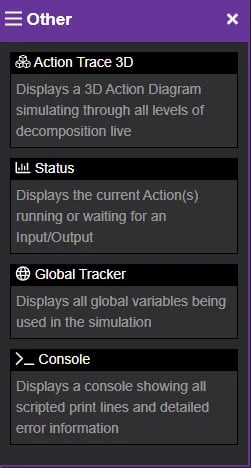Sopatra Discrete Event Simulator
Sopatra’s real-time Discrete Event Simulator allows you to execute a complex system as a discrete sequence of actions in time.
Discrete event simulation (DES) is the process of codifying the behavior of a complex system as an ordered sequence of well-defined events.
Sopatra’s real-time ‘Discrete Event Simulator’ allows you to execute a complex system as a discrete sequence of actions in time. This simulator is designed for analyzing a system, schedule, and performance. Sopatra’s simulation technology can be used for:
- Analyzing complex systems behavior and its parts (assets)
- Predicting system performance
- Identifying process bottlenecks
- Planning a schedule
- Verifying the correct logical design
By using Sopatra’s simulator, you can ensure that the simulation model and the functional model remain consistent throughout the lifecycle of your project. This prevents inaccuracies and inconsistencies that often occur when using external simulation tools.
Available Panels
Within the ‘Discrete Event Simulator,’ there are four (2) categories of panels, listed below, which are available to be displayed.
Time Panels

Note: Total Time Panel Displays the Total Time
as well as the ToP time and the AOTW Time.
Other Panels

Available Settings
- Display Mode: Enables switching between a dark theme and a light theme view of the simulator.
- Calendar mode: Enables calendar-driven simulations based on the entity ‘Start’ attribute. By default, if Calendar Mode is enabled and the root entity doesn’t have a ‘Start’ attribute set, the current time is used as the sim start time.Note: To use Calendar Mode, all actions in the sim must either not have a ‘Start’ attribute or one that occurs after the root entity ‘Start’ time.
- Speed: The speed of the simulator controls the screen animation frame rate. The speed is set to the proportions of real-time speed.
- Decisions: By default, if an ‘OR’ or a ‘LOOP’ is missing a script, then a prompt will display for you to make the decision. This can also be set to automatically make a uniformly distributed decision across the ‘OR’ and ‘LOOP’ branches.
- Start: The simulator can be started in debug mode which will start the simulator paused on the first Action. Actions can then be stepped to debug issues in your model.
- Hours per year: Enables simulating an average working calendar year, e.g. 1860 working hours per year.
- Random seed: Enables seeding the random number generator with the text you supply. This is useful for debugging or having the simulator run the same decisions/distributions through independent runs.
Note: For A Guided Tour on how to use the simulator, please go to Discrete Event Simulator.
